Grand Seiko 1960 Re-Creations: Celebrating A Turning Point
December of 1960 was a momentous month for more reasons than just eggnog and some light caroling. Events were in motion all around the world that many wouldn’t understand the impact of for years – or generations.
Paleoanthropologist Louis Leakey discovered a 1.4 million-year-old homo erectus fossil in Tanzania, while Ghana ended diplomatic relations with Belgium, and the Ivory Coast claimed independence from France. And that was just the first week on one continent.
A couple weeks later, France performed a nuclear test, while in the United States the Mercury-Redstone 1A reached suborbital altitudes of 210 km in a test flight, paving the way for the first humans to set foot on the moon later in the decade.
But the very next day, the Viet Cong officially formed in south Vietnam, and Auschwitz commandant Richard Baer was arrested in West Germany.
On December 23, Zindzi Mandela was born to Nelson Mandela and Winnie Madikizela-Mandela in Johannesburg, South Africa, just five days after the United Nations officially condemned apartheid. Some familiar names entered the world in December 1960, including Daryl Hannah, Julianne Moore, Kenneth Branagh, and Jean-Michel Basquiat.
The month saw a whole host of happenings in sports, politics, science, entertainment, and sadly a few notable tragedies. Yet for many it was simply the holiday season, which saw people celebrating the last month of the first year of a new decade – a decade that would be one of the most transformative in modern history, and that is saying a lot.
Given everything that happened in December 1960 and what we know would come to pass in the future, one event in Japan about alter the course of watchmaking in the country from that point forward might have escaped notice.
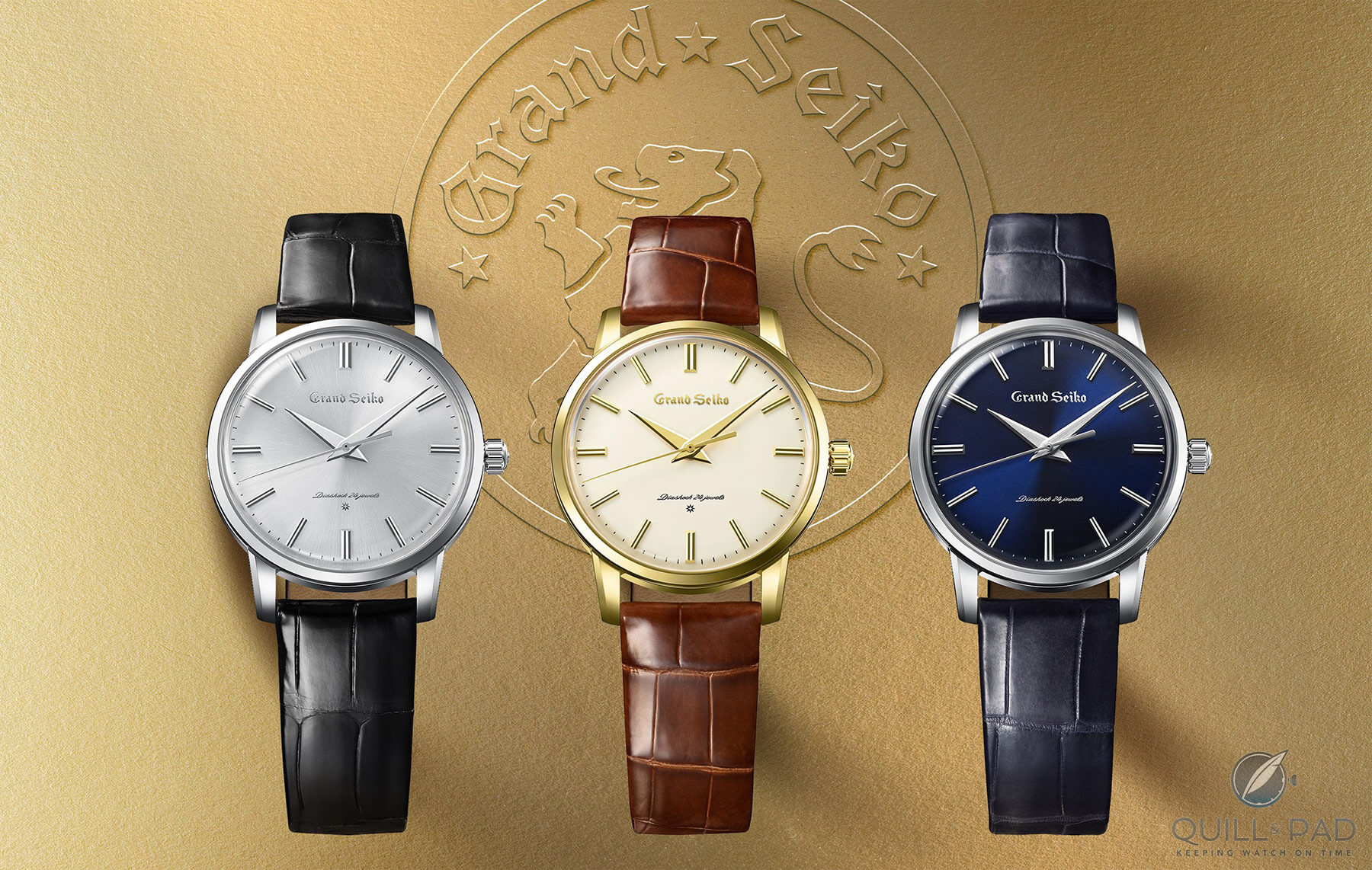
Grand Seiko 1960 Re-Creations: (L-R) platinum, yellow gold, and Brilliant Hard Titanium
December 18, 1960
On December 18, 1960, Seiko debuted the results of months (or, more accurately, years) of hard work and launched the Grand Seiko, a 25-jewel manual-winding timepiece doing double duty as the first chronometer-grade watch ever manufactured in Japan.
The watch became a brand in itself, and Grand Seiko eventually went on to define Japanese haute horlogerie, even though nine years later the brand released the first ever quartz watch — on Christmas day 1969, no less — which almost spelled doom for the entire mechanical watch industry.
Now, 60 years later, it’s clear that the industry survived, and that Grand Seiko is a significant part of the massive Japanese watchmaking industry.
To celebrate that enduring legacy, Grand Seiko has re-created the original Grand Seiko model from December of 1960 and it is all the right kinds of vintage Japanese minimalist design that any self-respecting WIS would appreciate.
Grand Seiko 1960 Re-Creations
The Grand Seiko Elegance 1960 Re-Creation is a solid representation of the essence of Grand Seiko.
This is the second re-creation model after the limited edition re-issue that marked the separation of Grand Seiko into its own brand in 2017. These new models are a permanent part of the collection and available in three metals: platinum, 18-karat yellow gold (as opposed to the original 14-karat gold filled version), and Brilliant Hard Titanium.
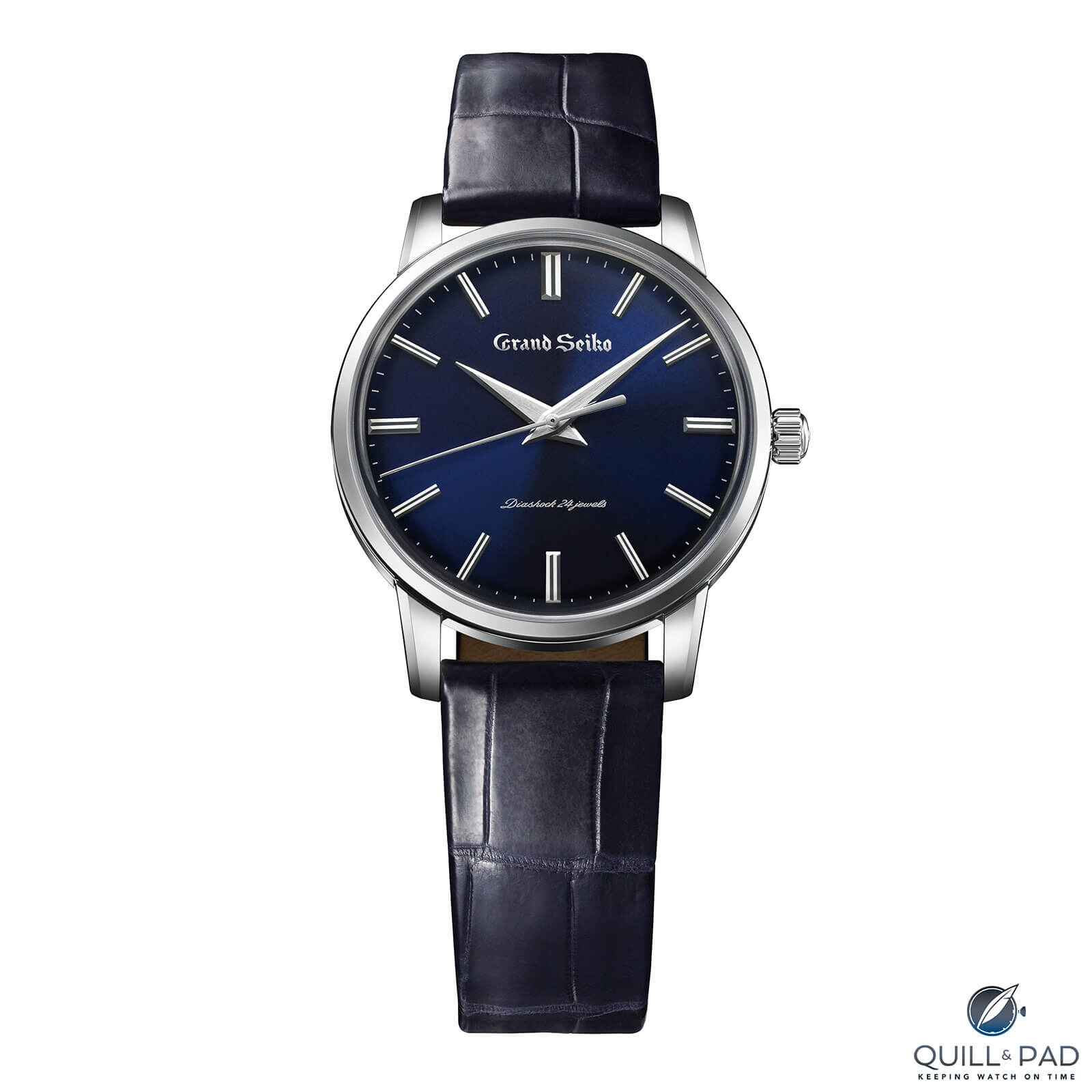
Grand Seiko 1960 Re-Creation in Brilliant Hard Titanium
Brilliant Hard Titanium is a titanium alloy that is (surprise, surprise) extra hard and able to hold a polish similar to stainless steel. It is exclusive to Grand Seiko and has been seen only once prior to the 1960 Re-Creations, in the SBGR305, the very first independent Grand Seiko after the collection became its own brand in 2017.
Each of the three case materials has a different dial, and each is like looking through a portal into the past.
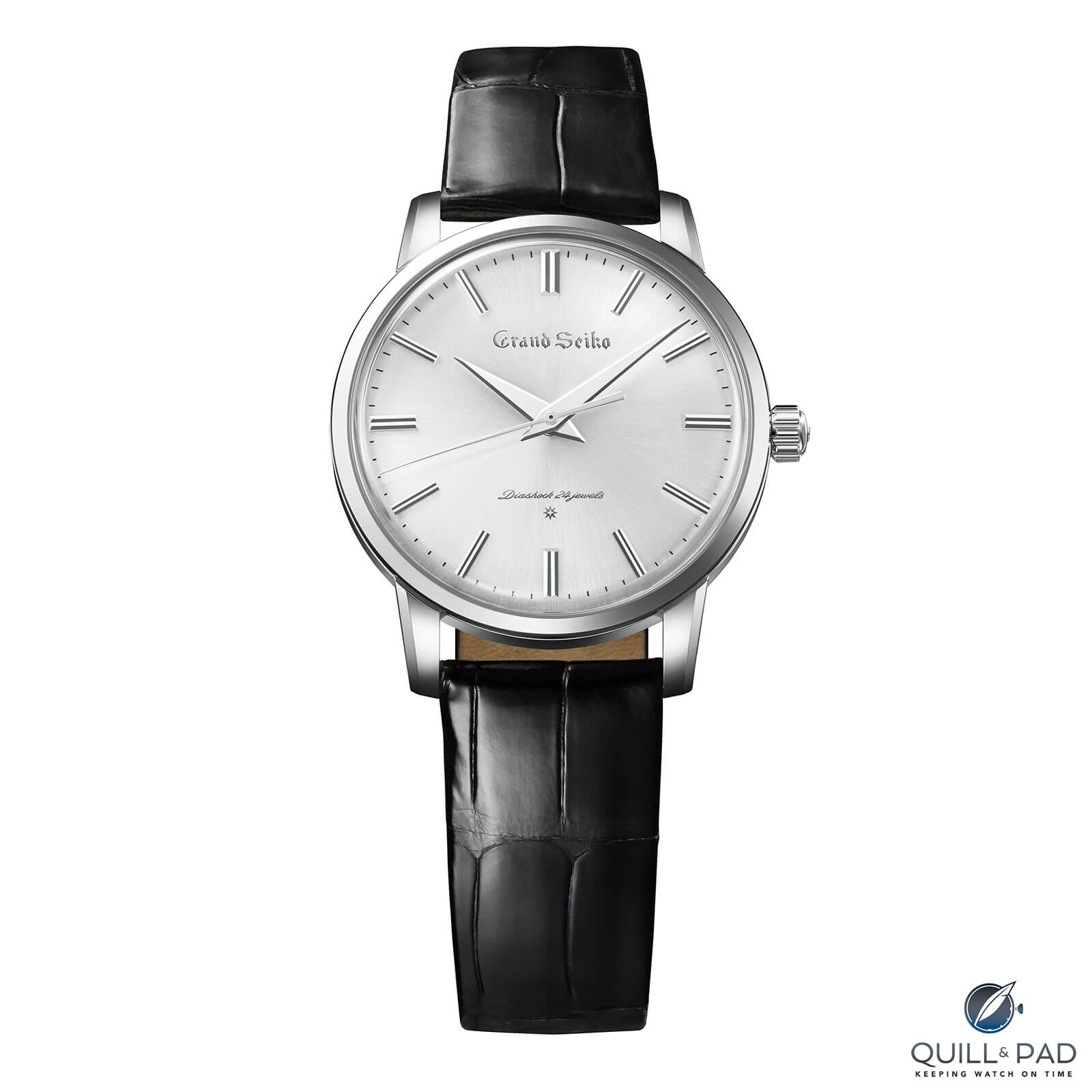
Grand Seiko 1960 Re-Creation in platinum
The new models are around 98 percent identical to the original model, with most of the changes being minor proportion adjustments, updating to a more modern size, and the removal of the word “chronometer” from the dial. Otherwise they are nearly perfect aesthetic reproductions of the original (from the front at least).
The original Grand Seiko, often called Reference 3180 due to its Caliber 3180, was “designed” during the days when Seiko didn’t have a fully fleshed out design department; Taro Tanaka, the man who would eventually define the aesthetic of Seiko a few years later, was still working to develop a design mindset within the company.
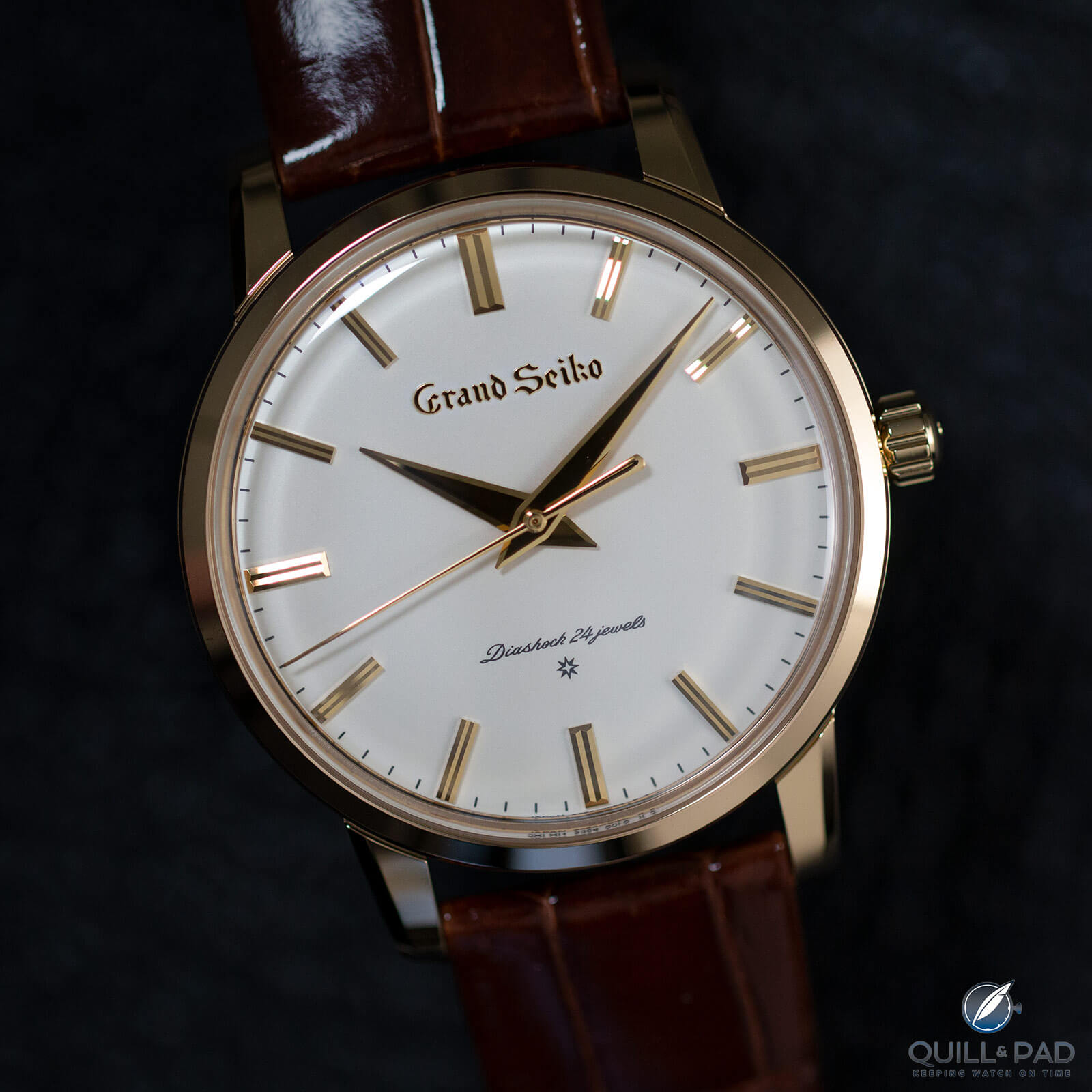
Live photo of a Grand Seiko 1960 Re-Creation prototype in yellow gold
The first Grand Seiko and the new re-creation have a very simple and straightforward design with a simple round case, slightly tapered and chamfered lugs, and a smooth angled bezel. The crown is somewhat ruggedly fluted, a detail that seems somewhat incongruous with the overall design, probably because it wasn’t holistically conceived with the rest of the details.
Before the design department fully put its stamp on everything with Tanaka’s rules (dubbed the “Grammar of Design” and developed in 1962), design elements were handled by the departments that made them, leading to the case design to be overseen by the case making department.
This is why the second generation of Grand Seiko saw a new case design but retained pretty much the original dial, markers, hands, and logo, likely the aspects initially designed by the budding design department (under Tanaka) in 1960.
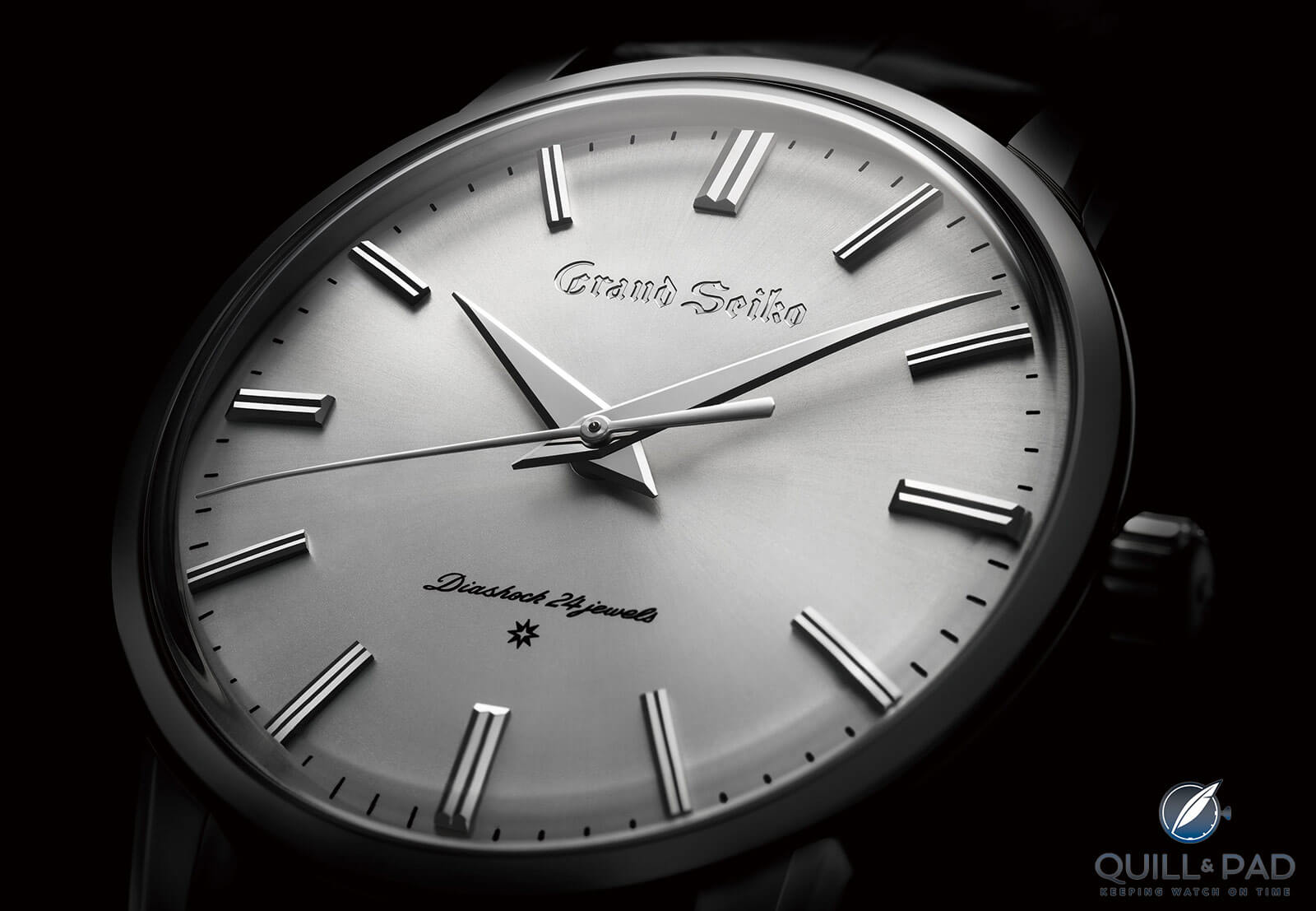
Dial of the platinum Grand Seiko 1960 Re-Creation
But this is why the original, and now the re-creation, is so distinct: it was the first, and last, Grand Seiko designed (in part) by the Japanese craftspeople who made the components. The dial is either a clean soft white, a finely sunburst-brushed silver, or an equally finely brushed sunburst cobalt blue with the tiniest minute tick printed on the edge of the dial.
The hour markers are applied double trapezoids, with slightly larger ones at 3, 6, and 9 and the largest at 12.
Chamfered dauphine hands and a thin tapered second hand create a very sharp appearance, with the second and minute hand tips slightly curved downward toward the dial, which slopes away right near the edge.
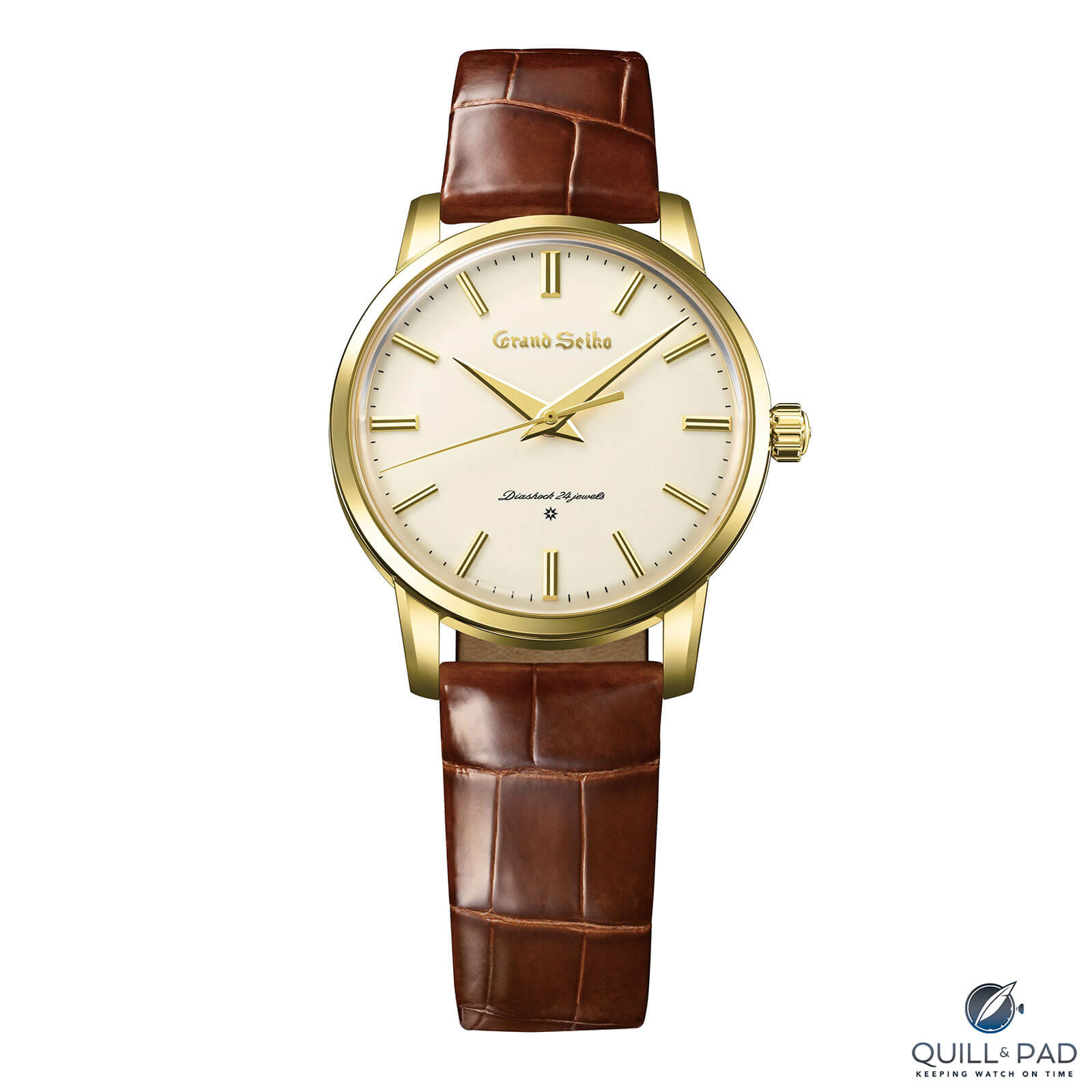
Grand Seiko 1960 Re-Creation in yellow gold
The logos and words on the dial are the biggest visual departures, and even these are minor. The Grand Seiko logo is engraved into the 18-karat gold dial of the platinum-encased version, while the yellow gold variation features an applied logo. The first limited edition re-creation from 2017 added a printed logo for the stainless steel, which has found its way onto the titanium version this time.
Why the tweaks?
As previously mentioned, the word “chronometer” does not appear, even though Caliber 9S64 exceeds official Swiss chronometer-testing institute C.O.S.C. standards with a -3/+5 deviation per day, though stated as the static measurement.
The removal of the chronometer designation occurred back in the mid-1960s after the Swiss acted very – well – Swiss, complaining that an internal testing procedure at Seiko disqualified it for the designation.
Watch nerd conspiracy theory side note: Grand Seiko spent the 1960s winning chronometry competitions in Japan and later in Switzerland, and I have to wonder if it was partly due to the Swiss complaint over the use of the word chronometer. Seiko removed the word but still proceeded to make incredibly precise movements, culminating with the V.F.A. models released in 1969 with a monthly rate of +/- 1 minute, or 2 seconds per day or less. And then, as if to rub salt in the wounds of the Swiss, Seiko released the Quartz Astron, the first quartz wristwatch, which had an accuracy rate of +/-5 seconds per MONTH, thus effectively killing the chronometer designation as having much functional meaning.
The only other change from the original dial is the star logo and the words “Diashock 24 Jewels.”
The original Caliber 3180 had 25 jewels (hence “25 jewels” on the dial) likely due to the use of four sets of anti-shock fittings. The modern 9S64 caliber has only 24 jewels, which may come down to only using two sets of anti-shock fittings and some updates elsewhere. As I said, a minor visual change.
Lastly, the star logo does not appear on the dial of the titanium-encased version: that star logo was meant to indicate that the hour markers were made of 18-karat gold – which is why the platinum and yellow gold versions have this mark (the markers are in fact gold) but in the titanium-cased version they are not, though it is not stated if they are the same Brilliant Hard Titanium or simply stainless steel.
But beyond those small changes and the fact that the tail of the second hand is a bit longer, these watches are spitting images of the original Grand Seiko from 1960, if scaled up a bit. The original size of 35 mm has now been expanded to 38 mm, which the first re-creation in 2017 had as well. The larger scale helps it fit in with modern sensibilities while still retaining the gentle proportions of a historic watch.
It feels pretty much the same . . . until you flip it over.
Grand Seiko 1960 Re-Creation from the back
Gone is the solid case back (another element the first re-creation retained), in its place a more modern sapphire crystal case back that allows appreciation of the beautifully restrained Caliber 9S64.
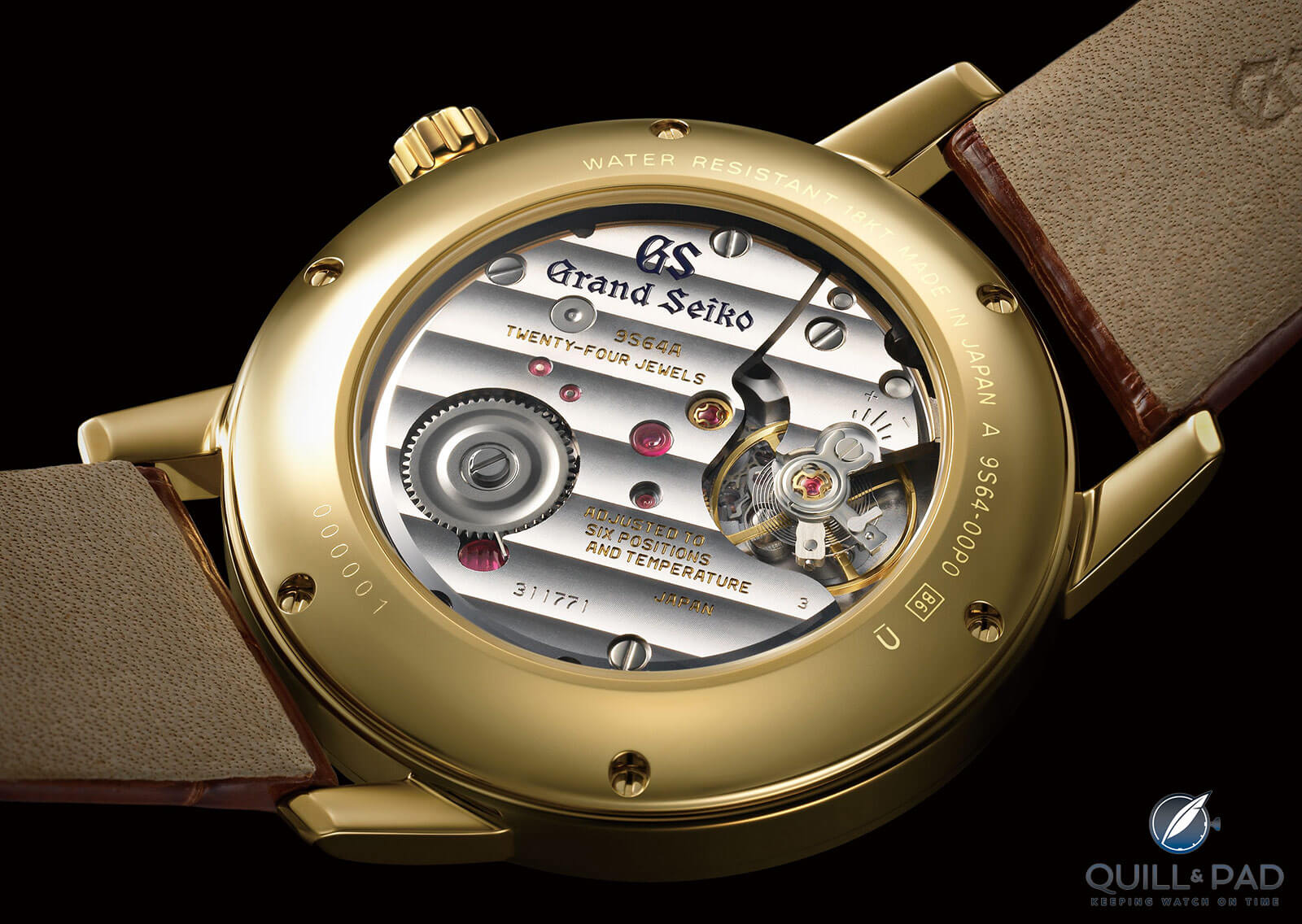
Grand Seiko Caliber 9S64 visible through the display back of the 1960 Re-Creation in yellow gold
This is a three-quarter plate movement like the hardy and traditional German movements: the caliber is a solidly simple movement that epitomizes the Japanese aesthetic, which revels in the accomplishment of getting the basic details perfect.
This isn’t always the case with haute horlogerie, and even Grand Seiko has many examples of stunning and complex movements with intricate finishing and decoration.
The 9S64 comes across as the same vein as a Rolex or many Patek Philippe movements: perfectly executed without superfluous adornment, seeking only excellence and forgoing vanity.
Over the decades, Seiko and Grand Seiko have worked hard to develop a culture of design and manufacturing excellence that only rarely ventures into the “métiers d’art” playground of expression, focusing instead on doing the simple things to the highest levels.
And even though the first Grand Seiko was conceived before the official “Grammar of Design” rules were laid out for all future models, it still follows those rules.
The aesthetic of the 1960 Re-creation harmonizes with the Seiko look that we know and love, yet due to its unique time in history feels slightly separate as if it was a flash in the night, a shooting star gone too soon.
For this reason it feels timeless yet current, the only detail giving it away is the obviously vintage character of the dial.
I feel that adding the Grand Seiko 1960 Re-creation to the permanent collection is a perfect way to provide a baseline for the brand and its progression over the last 60 years. It also highlights that the aesthetic of Grand Seiko has evolved over six decades but never strayed too far from its roots thanks to a firm foundation put in place by Taro Tanaka.
The more affordable titanium model is calling my name and I would gladly recommend any of the trio to a collector looking for a watch as a life-long companion.
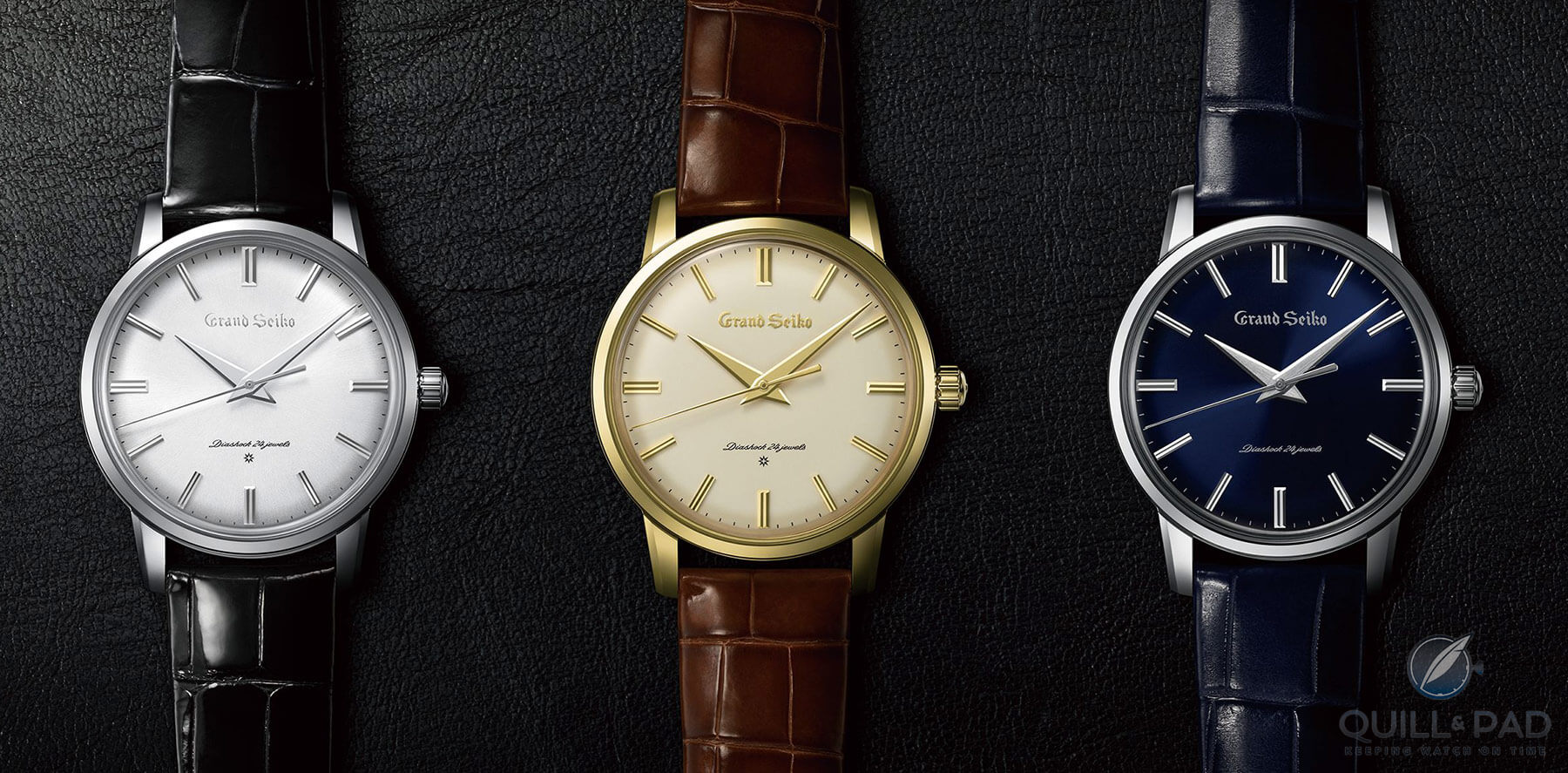
Grand Seiko 1960 Re-Creations: (L-R) platinum, yellow gold, and Brilliant Hard Titanium
That is, after all, what Seiko is all about: a connection to a reliable and faithful object, built by passionate craftspeople with an eye for perfection of the simplest details. Some may say this isn’t the traditional Japanese aesthetic, but in every way that counts it fulfills a cultural ideal.
One thing you never have to worry about is a Grand Seiko breaking down, so I’ll break it down like this.
- Wowza Factor * 8.2 The biggest wow factor for this watch is actually comparing it to the original and realizing how true to form it is!
- Late Night Lust Appeal * 91» 892.405m/s2 This trio has enough late-night lust appeal to keep you firmly planted in your chair for days!
- M.G.R. * 55 A crisply clean and highly accurate movement made to Grand Seiko standards: it’s a no brainer!
- Added-Functionitis * N/A Remember what I said about avoiding the superfluous, this is a part of that. No extra added functions, just a high-quality, supremely functional watch that means you can skip the Gotta-HAVE-That cream and just enjoy the experience!
- Ouch Outline * 9.8 Agony of exertion! If you haven’t worked out in a long time because you have been too focused on work, those first few workouts can be brutal. Still, I’d gladly take that feeling of a body questioning why I am doing this if it meant I got one of these pieces on my wrist!
- Mermaid Moment * So fresh and so clean! Minimalism means different things to different cultures, and a simple, clean watch to the Japanese is perfectly personified by this Grand Seiko 1960 Re-creation!
- Awesome Total * 778 First take the hours of power reserve (72) and multiply by the number of jewels in the movement (24), then subtract purity of the platinum (950) for a satisfyingly simple awesome total!
For more information, please visit www.grand-seiko.com.
Quick Facts Grand Seiko Elegance 1960 Re-creations
Case: 38 x 10.9 mm, platinum, yellow gold, or Brilliant Hard Titanium
Movement: manual winding Caliber 9S64 with 72-hour power reserve, 28,800 vph/4 Hz frequency
Functions: hours, minutes, seconds
Price: $38,000 in platinum, $26,000 in yellow gold, and $8,000 in titanium; available only through Grand Seiko Boutiques, expected to be available at the end of summer 2020
You may also enjoy:
Grand Seiko: Already Big In Japan And Getting Bigger Near You
Grand Seiko: A New Direction With New Models For 2017
Seiko Celebrates 20th Anniversary Of Grand Seiko 9S Caliber With 4 New Models
Grand Seiko’s Urushi Dials Give The Elegance Collection A Competitive Edge (And Eye Candy)
Why I Bought It (Despite The Strap And Buckle): Grand Seiko Blue Snowflake Reference SBGA407
Leave a Reply
Want to join the discussion?Feel free to contribute!



Very favolous
Fantastic review, thank you very much! I am thinking about buying this as my first and only Grand Seiko. Would you consider this to be a good choice or would go for another model in this case? Many thanks in advance!
Watch
I love Seiko watch as I have some of them in some models but Grand Seiko.
GS is indeed my dream watch since I was studying at Tokyo University for master and PhD in 1987 to 1992, and then a professor.
I wish my dream watch would come true soon…